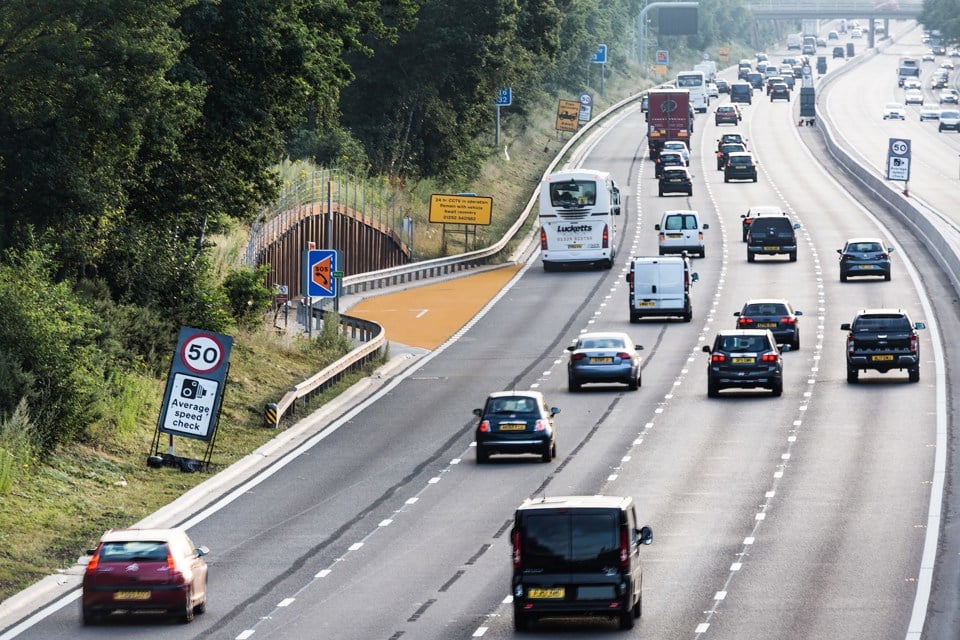A year after the Government cancelled plans for new smart motorways, the RAC is calling on ministers to introduce further changes to improve safety.
New smart motorways – including 11 that had already been paused and three new schemes – were ditched in April 2023, with ministers citing financial pressures and a lack of public confidence.
Seven of the 14 projects were going to involve converting stretches of motorway into ‘all-lane running’ roads where the hard shoulder is permanently removed.
They will now remain as ‘dynamic’ smart motorways where the hard shoulder can be opened as an extra lane during busy times.
However, to mark the first anniversary of the Department for Transport (DfT) decision, the RAC has reiterated its argument that it should either convert existing all-lane-running (ALR) smart motorways to ‘dynamic’ ones, where the hard shoulder is only opened to traffic during busy periods, or permanently reintroduce a permanent hard shoulder on these roads.
RAC head of policy, Simon Williams, said: “It’s incredible to think that a decade has gone by since the first all-lane-running stretch of smart motorway opened on the M25 in Hertfordshire, and that it’s a year to the day since the Prime Minister cancelled all 14 future schemes, citing financial pressures and a lack of public confidence in them.
“There is a real irony when it comes to talking about cost pressures in relation to these distinctly unpopular types of motorway.
“While heralded as a cost-effective way of increasing capacity on some of our busier roads, a colossal amount of public money has since gone into trying to make them safer – for instance by installing radar-based technology to detect stricken vehicles more quickly, plus the creation of additional emergency refuge areas.
“This cash needn’t have been spent had the Government not taken the decision to plough on with building all-lane running motorways, regardless of concerns expressed by drivers, the RAC and even the Transport Committee.”
However, Williams says the question remains: will the motoring public ever be entirely comfortable driving on the 200-plus miles of motorway where the hard shoulder has been permanently removed?
“The hard shoulder is by no means a safe location, but in the event of a breakdown, it is far safer than being stranded in a live lane of traffic waiting for the ‘red X closed lane’ sign to be turned on and then for other drivers to do the right thing and move into another lane,” he explained.
“We continue to believe that the Government should either convert existing all-lane-running smart motorways to ‘dynamic’ ones, where the hard shoulder is only opened to traffic during busy periods, or repaint the white line and reintroduce a permanent hard shoulder on these roads.
“In either case, queue-busting technology, such as variable speed limits, could remain to help ensure traffic flows as smoothly as possible.”
The latest National Highways report shows there were 193 miles of all-lane-running motorways as of 2021. Since then, work has progressed on completing schemes on the M6 and M56
RAC research released in April 2023 showed seven-in-10 drivers (69%) wanted the hard shoulder to be reinstated on existing all-lane-running smart motorways, regardless of the Government claiming it would be too disruptive and costly.
Separate RAC research released in December 2022, showed half of drivers (49%) said they frequently or occasionally avoid using lane one on all-lane-running smart motorways, and three-quarters (77%) of these said they were worried they might encounter a stationary, broken-down vehicle as there is no hard shoulder.






















curly - 15/04/2024 22:18
Hard Shoulder – now Shoulder It is time drivers in UK shortened the ancient name of Hard Shoulder, to Shoulder. Many countries around the world refer to it as just ‘Shoulder’. History: In 1958 when the first motorway was opened in UK, it was constructed with 2 driving lanes and a “Soft” shoulder. “Soft” shoulders were surfaced only with loose gravel, and if a fully loaded lorry used it, they would typically sink in and get stuck, requiring a tow back onto the driving lane. Also when any vehicle left the soft shoulder they would typically throw loose gravel onto the driving lane, which would later be thrown up by the tyres of a passing vehicle and smash the windscreen of the vehicle behind. Thus, it wasn’t many years before Soft shoulders were replaced with a properly surfaced Hard shoulder. However, all that was almost 60 years ago, since then, in UK all shoulders have a Hard surface over a solid foundation. It would also make signage easier by having 1 word less for drivers to read in necessary driving circumstances, and in literature e.g. the Highway Code, Driving Manuals, and theory tests, etc. Summary: forget the word hard, it is just a “Shoulder”.